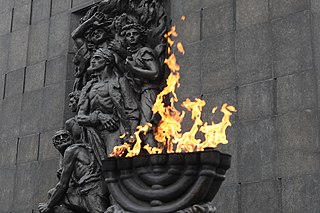 W
WThe 1946 pacification of villages by PAS NZW was the killing that year of 79 Polish nationals of Belarusian ethnicity in the area of Bielsk County, north-eastern Poland, by partisans, members of the Polish Extraordinary Special Actions unit of the National Military Union (NZW). These murders took place in the aftermath of World War II.
 W
WThe history of Germans in Poland dates back almost a millennium. Poland was at one point the largest kingdom in Europe; it was also Europe's most multiethnic state during the medieval period. It covered an immense plain with no natural boundaries, with a thinly scattered population of many ethnic groups, including the Poles themselves, Germans in the cities of West Prussia, and Ruthenians in Lithuania. 5-10% of immigrants were German settlers.
 W
WThe history of the Ukrainian minority in Poland dates back to the Late Middle Ages, preceding the 14th century Galicia–Volhynia Wars between Casimir III the Great of Poland, and Liubartas of Lithuania. Following the extinction of the Rurikid dynasty in 1323, the Polish Kingdom extended further east in 1340 to include the lands of Przemyśl and in 1366, Kamianets-Podilskyi. After the Union of Lublin (1569), principalities of Galicia and Western Volhynia became, what is known as, the Ruthenian Voivodeship of the Polish Crown, while the rest of Red Ruthenia together with Kiev came under Lithuanian control. The Polish borders reached as far east as Zaporizhia, and Poltava.
 W
WThe history of Jews in Poland dates back at least 1,000 years. For centuries, Poland was home to the largest and most significant Jewish community in the world. Poland was a principal center of Jewish culture, because of the long period of statutory religious tolerance and social autonomy which ended after the Partitions of Poland in the 18th century. During World War II there was a nearly complete genocidal destruction of the Polish Jewish community by Nazi Germany and its collaborators, during the German occupation of Poland between 1939 and 1945, called the Holocaust. Since the fall of communism in Poland, there has been a renewed interest in Jewish culture, featuring an annual Jewish Culture Festival, new study programs at Polish secondary schools and universities, and the opening of Warsaw's Museum of the History of Polish Jews.
 W
WKashubian Unity Day - is an annual festival celebrated every March 19 to commemorate the first historical written mention of Kashubians, in Pope Gregory IX's Bull of March 19, 1238. In this bull, the Pope referred to Prince Bogislaw I of Pomerania as duce Cassubie.
 W
WOlędrzy were people, often of Dutch or German ancestry, who lived in settlements in Poland organized under a particular type of law.
 W
WWalddeutsche is the name for a group of people of mostly German origin, who settled between the 14th and 17th century on the territory of present-day Sanockie Pits, in southeastern Poland. The Walddeutsche peopled migrated to the Pit region which was previously only sparsely inhabited because the land was difficult to farm.